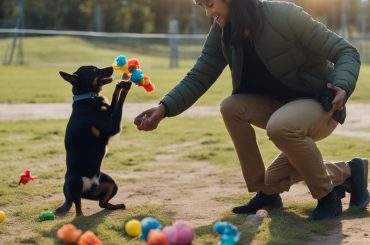Teaching your dog new tricks can be a rewarding experience for both of you. One popular trick that many dog owners want to teach their furry friends is how to roll over. Not only is it an impressive command, but it also helps strengthen the bond between you and your pet. In this article, I will guide you through the step-by-step process of teaching your dog to roll over.
Key Takeaways:
- Teaching your dog to roll over is a fun and rewarding trick.
- Start training your dog when they are younger for better results.
- Training your dog tricks offers numerous benefits, including improved obedience and stronger communication.
- Reward-based training is an effective method to teach your dog.
- Follow a step-by-step guide and incorporate patience and consistency in the training process.
When to Start Teaching Your Dog Tricks

If you’re wondering when to start teaching your dog tricks, the answer is as soon as you bring them home. While it’s easier to teach tricks to younger dogs, adult dogs can also learn with patience and the right approach. Training your dog tricks not only provides mental stimulation but also strengthens the bond between you and your pet.
For puppies, the recommended time to start training classes is between 12 to 16 weeks of age, after they have received their vaccinations. Puppies are more responsive and eager to learn at this age. However, if you have an adult dog, don’t worry! With consistent training and positive reinforcement, they can also learn new tricks.
Remember that teaching tricks is a gradual process that requires patience and consistency. Start with basic commands like sit and stay before moving on to more complex tricks like roll over. By breaking down the training into smaller steps and using rewards, you can make the learning process enjoyable for both you and your dog.
Tips for Teaching Tricks:
- Use positive reinforcement: Reward your dog with treats, praise, and play for successfully performing the trick.
- Keep training sessions short and frequent: Dogs have short attention spans, so it’s best to have multiple short sessions rather than one long session.
- Be consistent: Use the same commands and hand signals every time you train your dog to reinforce their understanding.
- Be patient: Dogs learn at their own pace, so don’t get discouraged if progress is slow. Stay calm, patient, and persistent.
“Training your dog tricks not only provides mental stimulation but also strengthens the bond between you and your pet.”
Teaching your dog tricks is a rewarding experience that can bring you closer to your furry friend. It’s a fun way to keep them mentally stimulated, and it allows you to spend quality time together. Remember to have realistic expectations and celebrate small successes along the way. With time and dedication, your dog will become a trick-performing superstar!
| Benefits of Teaching Tricks to Your Dog | Importance of Starting Early |
|---|---|
| 1. Mental stimulation | 1. Puppies are more receptive at a younger age |
| 2. Strengthened bond between you and your dog | 2. Training becomes a part of their routine |
| 3. Increased confidence in your dog | 3. Builds a foundation of obedience |
| 4. Enhanced communication skills between you and your dog | 4. Mental stimulation for adult dogs |
The Benefits of Training Your Dog

Training your dog to roll over, or any other trick, offers numerous benefits. It helps develop your dog’s patience, increases their confidence, and improves their communication skills with you. Training improves their obedience and strengthens the bond between you and your dog. It also provides mental stimulation and keeps your dog active. Teaching tricks is a great way to spend quality time with your pet and create cherished moments together.
| Benefits of Training Your Dog | Explanation |
|---|---|
| Patience Development | Training teaches your dog to wait and follow instructions, enhancing their patience levels. |
| Increased Confidence | Learning new tricks boosts your dog’s self-confidence and sense of accomplishment. |
| Better Communication | Training strengthens the bond between you and your dog, improving your ability to understand each other. |
| Obedience Enhancement | Trained dogs are more likely to obey commands, leading to a well-behaved and obedient pet. |
| Mental Stimulation | Training provides mental exercise, preventing boredom and promoting overall well-being. |
Your dog’s physical health also benefits from training as it keeps them active, reducing the risk of obesity and associated health issues. The positive reinforcement used in training is an effective way to shape behavior and ensure your dog enjoys the learning process. By rewarding desired behaviors, you motivate your dog to continue learning and behaving appropriately.
Training your dog is not just about teaching them tricks; it’s about nurturing their overall development and well-being. The time and effort invested in training will strengthen the bond between you and your furry companion, creating a mutually rewarding relationship.
So, whether you’re teaching your dog to roll over or mastering other commands, remember the many benefits that come with training. Enjoy the journey of learning together and revel in the joy of a well-trained, happy dog.
The Importance of Reward-Based Training

In the world of animal training, reward-based training has gained significant popularity and recognition as an effective and humane method for teaching animals tricks and commands. This training approach revolves around using positive reinforcement, such as treats or toys, to reward desired behavior. By doing so, the animal is motivated to repeat the behavior, making the training process enjoyable and engaging for both the trainer and the animal.
One of the key advantages of reward-based training is that it creates a positive association between the desired behavior and the reward. This association enhances the animal’s willingness to learn and obey commands. When dogs are rewarded for performing a trick, they are more likely to exhibit the behavior again in the future. This method also fosters a strong bond between the trainer and the animal, as it emphasizes trust, cooperation, and mutual understanding.
Unlike punishment-based training methods, which may induce fear or stress in animals, reward-based training focuses on encouraging and reinforcing the desired behavior. It promotes a positive, nurturing environment in which animals feel safe and secure to explore and learn. By utilizing rewards and praise, trainers can effectively communicate their expectations and guide animals towards success.
To summarize, reward-based training is a humane and effective approach to teaching animals tricks and commands. By using positive reinforcement, trainers can motivate their animals and create a strong foundation for learning and behavior modification. This method not only produces impressive results but also fosters a trusting and harmonious relationship between the trainer and the animal.
The Benefits of Reward-Based Training:
- Motivation: Animals are motivated to perform desired behaviors in order to receive rewards, making training engaging and enjoyable.
- Bonding: Reward-based training strengthens the bond between the trainer and the animal, fostering trust and cooperation.
- Positive Association: Animals develop a positive association between the desired behavior and the reward, increasing the likelihood of repetition.
- Humane Approach: Reward-based training focuses on positive reinforcement and avoids the use of punishments, creating a safe and nurturing environment.
Step-by-Step Guide to Teach a Dog to Roll Over

To teach your dog to roll over, follow these step-by-step instructions:
Step 1: Establish the “Down” Cue
Before you begin teaching your dog to roll over, ensure that they understand the “down” cue. This can be achieved by using a treat to guide your dog into a lying position. Practice this cue until your dog responds consistently.
Step 2: Lure Your Dog onto Their Side
Hold a treat close to your dog’s nose and then slowly move it towards their shoulder. As your dog follows the treat, they will naturally shift their weight onto their side. Reward them with the treat and praise them for their effort.
Step 3: Guide Your Dog to Roll Over
Once your dog is comfortably on their side, use another treat to guide them further. Move the treat towards their back, encouraging them to roll onto their back. Reward and praise them again when they complete the motion.
Step 4: Repeat and Refine
Continue practicing these steps until your dog can perform a full roll over. Gradually reduce the use of treats and hand motions, relying more on verbal cues. Be patient and consistent with your training, and always reward your dog for their progress.
Remember, every dog learns at their own pace, so be flexible and adjust the training to suit your dog’s needs. With time and practice, your furry friend will master the roll over trick and impress everyone with their skills!
| Benefits of Teaching Your Dog to Roll Over | Key Reminders |
|---|---|
|
|
Tips for Teaching a Dog to Roll Over

Teaching a dog to roll over can be a fun and engaging training exercise. Here are some tips to help you successfully teach your dog this trick:
1. Start with the Basic Commands
Before you begin teaching your dog to roll over, make sure they are familiar with basic obedience commands such as “sit” and “down.” This will provide a solid foundation for more advanced tricks like rolling over.
2. Break it Down into Smaller Steps
Break the roll over trick into smaller, manageable steps. Start by getting your dog to lie down on their side. Use treats and gentle guidance to encourage them to roll onto their back. Slowly increase the difficulty by asking for a full roll over.
3. Use Positive Reinforcement
Positive reinforcement is key to successfully teaching your dog any trick. Use treats, praise, and affection to reward your dog for their progress and successful attempts. This will motivate them to continue learning and performing the roll over trick.
4. Be Patient and Consistent
Teaching a dog to roll over may take time, so be patient and consistent with your training sessions. Practice the trick in short sessions multiple times a day. Consistency will help reinforce the behavior and make it easier for your dog to understand what you expect from them.
5. Seek Professional Help if Needed
If you’re having difficulty teaching your dog to roll over, don’t hesitate to seek professional help from a dog trainer or behaviorist. They can provide valuable guidance and techniques to overcome any training challenges.
Remember, teaching your dog to roll over should be a positive and rewarding experience. Enjoy the process and celebrate your dog’s progress along the way!
Key Reminders in Teaching a Dog to Roll Over
When teaching your dog to roll over, it’s important to keep a few key reminders in mind. These reminders will help ensure a successful training process and a happy, well-trained dog:
1. Start with the Basics
Before you begin teaching your dog to roll over, make sure they have a solid understanding of basic obedience commands such as “sit,” “stay,” and “down.” This foundation will make it easier for your dog to follow your instructions during the training process.
2. Be Patient and Consistent
Training takes time and patience, so it’s important to remain consistent and persistent with your efforts. Break the training into short, daily sessions and gradually increase the difficulty as your dog progresses. Remember to stay positive and provide lots of praise and rewards for each small achievement.
3. Use Positive Reinforcement
Positive reinforcement is a highly effective training method that involves rewarding your dog for desired behavior. Use treats, toys, and verbal praise to reward your dog each time they successfully roll over. This will help reinforce the behavior and make the training experience enjoyable for your furry friend.
4. Practice in a Distraction-Free Environment
When teaching your dog to roll over, it’s best to start in a quiet, distraction-free environment. This will help your dog focus and avoid getting overwhelmed. As your dog becomes more proficient, gradually introduce distractions to ensure they can perform the trick in any situation.
5. Adapt to Your Dog’s Individual Needs
Every dog is unique, so it’s important to adapt the training to your dog’s individual needs. Some dogs may pick up the trick quickly, while others may require more time and repetition. Stay attuned to your dog’s progress and adjust the training methods as necessary to ensure success.
By keeping these key reminders in mind, you’ll be well-equipped to teach your dog to roll over successfully. Remember to be patient, consistent, and always provide positive reinforcement. With time and practice, your dog will master this fun and impressive trick!
Recommended Training Resources for Dogs

When it comes to training your dog, having the right resources can make all the difference. Whether you’re a beginner or an experienced trainer, these recommended resources can help you in teaching your dog to roll over and mastering other tricks.
Dog Training Books
If you prefer a comprehensive guide that you can refer to anytime, dog training books are a valuable resource. Some highly recommended titles include:
- The Power of Positive Dog Training by Pat Miller
- Dog Training for Dummies by Jack and Wendy Volhard
- The Other End of the Leash by Patricia McConnell
Online Dog Training Courses
For those who prefer online learning, there are a variety of dog training courses available. These courses offer step-by-step instructions, video demonstrations, and personalized guidance. Some popular online platforms include:
- Udemy
- Karen Pryor Academy
- American Kennel Club
Professional Dog Trainers
If you prefer hands-on training with a professional, hiring a dog trainer can be a great option. A certified dog trainer can provide personalized guidance, address specific behavioral issues, and help you achieve your training goals. Look for trainers who use positive reinforcement techniques and have experience in trick training.
| Resource | Description |
|---|---|
| Dog Training Books | A comprehensive guide to training your dog, with step-by-step instructions and valuable insights. |
| Online Dog Training Courses | Interactive online courses that provide video demonstrations and personalized guidance for training your dog. |
| Professional Dog Trainers | Experienced trainers who can provide hands-on guidance, address specific behavioral issues, and help you achieve your training goals. |
Remember, each dog is unique, so feel free to explore different resources and find the ones that work best for you and your furry friend. The key is to be patient, consistent, and use positive reinforcement techniques. With the right resources and approach, you’ll be amazed at what your dog can achieve!
Wrapping Up
Teaching dogs new tricks through canine training is a fulfilling endeavor that strengthens the bond between you and your furry friend. By following step-by-step instructions, using positive reinforcement, and being patient and consistent, you can successfully teach your dog how to roll over. This impressive trick not only showcases their abilities but also provides mental stimulation and enhances their obedience.
Throughout the training process, it is important to remember a few key factors. Keep training sessions enjoyable and tailor them to your dog’s individual needs. Use high-value rewards that motivate and excite your dog. By making the training experience positive and rewarding, your dog will be more eager to learn and respond to your commands.
Unlock your dog’s potential today and embark on the journey of teaching them how to roll over. This rewarding experience will not only bring joy to both you and your dog but also create cherished moments that you’ll treasure for years to come. So, get started with your canine training and witness the amazing capabilities of your beloved pet!
FAQ
Can I start teaching my dog tricks as soon as I bring them home?
Yes, you can start teaching your dog tricks as soon as you bring them home. However, it is generally easier to teach them when they are younger.
When is the recommended time to start training classes for puppies?
The recommended time to start training classes for puppies is between 12 to 16 weeks of age, after they have received their vaccinations.
Can adult dogs be taught tricks too?
Yes, adult dogs can also be taught tricks with patience and the right approach.
What are the benefits of training your dog?
Training your dog offers numerous benefits, including patience development, increased confidence, improved communication skills, obedience improvement, and a stronger bond between you and your pet.
What is reward-based training?
Reward-based training is a method that involves rewarding your dog with treats or toys for desired behavior. It encourages your dog to work for a reward and makes training enjoyable for them.
How can I teach my dog to roll over?
Follow the step-by-step instructions provided in the article to teach your dog to roll over.
Any tips for teaching a dog to roll over?
Some tips for teaching a dog to roll over include using high-value rewards, keeping training sessions enjoyable, and tailoring the training to your dog’s individual needs.
What should I keep in mind when teaching a dog to roll over?
Key reminders include using positive reinforcement, being patient and consistent, and praising and rewarding your dog for their efforts.
Are there any recommended training resources for dogs?
Yes, there are recommended training resources available to help you in training your dog. Consult the article for more information.






